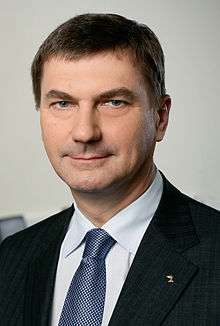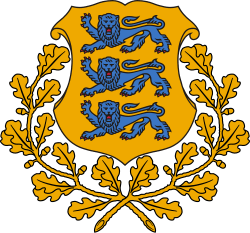Andrus Ansip
| Andrus Ansip | |
|---|---|
 | |
| European Commissioner for Digital Single Market | |
|
Assumed office 1 November 2014 | |
| President | Jean-Claude Juncker |
| Preceded by | Neelie Kroes (Digital Agenda) |
| 16th Prime Minister of Estonia | |
|
In office 12 April 2005 – 26 March 2014 | |
| President |
Arnold Rüütel Toomas Hendrik Ilves |
| Preceded by | Juhan Parts |
| Succeeded by | Taavi Rõivas |
| Minister of Economic Affairs and Communications | |
|
In office 23 September 2004 – 12 April 2005 | |
| Prime Minister | Juhan Parts |
| Preceded by | Meelis Atonen |
| Succeeded by | Edgar Savisaar |
| Mayor of Tartu | |
|
In office 10 September 1998 – 23 September 2004 | |
| Preceded by | Roman Mugur |
| Succeeded by | Laine Randjärv |
| Personal details | |
| Born |
1 October 1956 Tartu, Estonia |
| Political party | Reform Party |
| Spouse(s) | Anu Ansip |
| Children | 3 |
| Alma mater |
University of Tartu Estonian University of Life Sciences |
Andrus Ansip (Estonian pronunciation: [ˈɑndrus ˈɑnʲˑsʲip]; born 1 October 1956) is an Estonian politician currently serving as Vice President for the Digital Single Market in the European Commission. Previously, he was Prime Minister of Estonia from 2005 to 2014 and chairman of the liberal Estonian Reform Party (Estonian: Reformierakond) from 2004 to 2014.
Before his entry into politics Ansip trained as a chemist, before working in banking and business. He entered Parliament in 2004, quickly becoming Minister of Economic Affairs, and subsequently Prime Minister in April 2005. On 1 November 2014, he was appointed to the European Commission to serve as Vice President and European Commissioner for the Digital Single Market.
Early life and business career
Born in Tartu, Ansip graduated from the University of Tartu with a degree in Chemistry in 1979. He worked as an engineer at the university from 1979 to 1983 (with a two-year break for mandatory military service). He was an Instructor in the Industry Department and Head of the Organisational Department of the Tartu District Committee of the Estonian Communist Party from 1986 to 1988.[1] Ansip has been involved in several banking and investment ventures. He has served as a Member of the Board of Directors of the People’s Bank of Tartu (Estonian: Rahvapank), Chairman of the Board of Livonia Privatisation IF, and CEO of Investment Fund Broker Ltd (Estonian: Fondiinvesteeringu Maakler AS). He also has served as Chairman of the board for Radio Tartu.
Political career
Mayor of Tartu
In 1998, Ansip was elected as Mayor of Tartu as a candidate of the centrist-right Reformierakond (Reform Party), a position which he held until 2004, to great popular acclaim and very high ratings in the opinion polls. He had run in previous elections for the Riigikogu, the Estonian Parliament, but had always given up his seat in order to remain Mayor. He was succeeded by fellow Reform Party member Laine Jänes.
Chairman of Reform Party and Minister of Economics
On 21 November 2004, Ansip became Chairman of Estonian Reform Party because the party's founder and hitherto chairman, former Prime Minister Siim Kallas, had become EU Commissioner and Vice President and thus had to move to Brussels. It was obvious that Ansip would have to move to Tallinn, and a chance opened up when the Minister of Economic Affairs and Communications in the coalition government of Juhan Parts, Meelis Atonen, a party colleague, had to resign. Ansip became his successor on 13 September. His track record as Minister is more difficult to evaluate because of the short duration of his service.
Prime Minister
On 31 March 2005, Ansip was charged by President Arnold Rüütel to form a government, following 24 March 2005 resignation by Prime Minister Juhan Parts. Ansip was able to form a coalition with the Centre Party and the People's Union of Estonia, which was approved by the Riigikogu on 12 April 2005. Ansip thus became Prime Minister of Estonia. He was backed by 53 out of 101 members of the Riigikogu, 40 deputies voting against. He and the ministers were inaugurated in office the next day, on 13 April.
On 4 March 2007, Ansip's Reform Party won 27 percent of the vote in the Estonian parliamentary elections, raising its mandate in the Riigikogu to 31 seats from 19. Ansip personally received over 22,500 votes. He was charged by President Toomas Hendrik Ilves to form a government. This time the Reform Party formed a coalition with the Union of Pro Patria and Res Publica (IRL) and the Social Democratic Party. His second term as Prime Minister began on 5 April 2007. In May 2009, the Social Democrats left the government, and as coalition talks with the People's Union of Estonia failed, it was decided to continue with a minority government of the Reform Party and IRL.
.jpg)
In March 2011, the Reform Party won 33 seats in the Riigikogu, remaining the largest party even after the country's economic output had fallen by 14 percent in 2009 due to the global financial crisis and the collapse of a real estate price bubble fueled by cheap and easy credit from Nordic banks.[2] Ansip was once again charged by President Toomas Hendrik Ilves to form a government. The Reform Party continued in a coalition with the Union of Pro Patria and Res Publica. Ansip's third term as Prime Minister began on 6 April 2011, when Riigikogu approved his third cabinet.
But Ansip's center-right coalition soon struggled in polls amid signs of voter fatigue at years of a government focused on fiscal austerity as well as several high profile party funding scandals. The center-left opposition also gained popularity.[3]
On 4 March 2014, Ansip announced his resignation to enable a successor to lead his party into 2015 elections. From 4 December 2013 to 26 March 2014 he was the longest-serving prime minister in the European Union.[4]
Vice President of the European Commission
In the 2014 European elections, Ansip was elected as an MEP received the largest number of preferential votes in Estonia. Shortly after, Prime Minister Taavi Roivas nominated him as the country’s next European Commissioner.[5]
On the 10th of September 2014 President-Elect Juncker of the European Commission announced that he proposed Andrus Ansip as Vice-President of the European Commission and the European Commissioner for the Digital Single Market. He was formally appointed by the European Council as Vice President with the consent of the European Parliament.
Relocation of the Bronze Soldier of Tallinn
One of the most controversial actions of Ansip's government was relocation of the Bronze Soldier of Tallinn from a prominent location in the center of Tallinn to the Defence Forces Cemetery of Tallinn adjacent to the city center. The removal of the monument, as well as war graves, from its current location on 27 April 2007 led to mass protests and two nights of the worst rioting Estonia has seen since regaining independence.[6][7]
Personal life
Andrus Ansip is married to gynecologist Anu Ansip (b. 1956)[8] and they have three daughters Reet (b. 1977), who is a stomatologist; Tiina (b. 1981) who is a journalist and Liisa (b. 1997).[9]
Andrus Ansip is a member of the Estonian voluntary home guard organisation Kaitseliit (Defence League) since 10 November 2009.[10]
Awards
- On 31 July 2007 Ansip was recognized for "his service in fight for Estonian freedom and Estonian national idea" by Estonian Central Council in Canada.[11]
- Estonian Newspaper Association named Ansip Press Enemy of 2007.[12]
-
 Albania: On 5 April 2010 Received a copy of the key of the city of Tirana on the occasion of his state visit to Albania.[13]
Albania: On 5 April 2010 Received a copy of the key of the city of Tirana on the occasion of his state visit to Albania.[13]
References
- ↑ The Government of the Republic of Estonia: Andrus Ansip - Estonian Government Archived 13 August 2011 at the Wayback Machine.
- ↑ David Mardiste (March 4, 2014), Estonian PM submits resignation: president's spokesman Reuters.
- ↑ David Mardiste (March 4, 2014), Estonian PM submits resignation: president's spokesman Reuters.
- ↑ "Estonia PM Ansip resigns - Europe's longest-serving PM". BBC News. 4 March 2014.
- ↑ Dave Keating (March 30, 2014), Ansip nominated as Estonia’s commissioner European Voice.
- ↑ "BBC NEWS - Europe - Tallinn tense after deadly riots". Retrieved 3 March 2015.
- ↑ Olukord tänavatel on rahulik (Estonian)
- ↑ "Tartu Rotary klubi". Retrieved 3 March 2015.
- ↑ Referaat
- ↑ Andrus Ansip sai kätte Kaitseliidu liikmepileti Archived 20 July 2011 at the Wayback Machine.. Neljas.ee, 29 March 2010.
- ↑ "EV peaminister Toronto Eesti Majas. Video. - Estonian World Review". Estonian World Review. Retrieved 3 March 2015.
- ↑ "Eesti Ajalehtede Liit". Retrieved 3 March 2015.
- ↑ Received a copy of the key of the city of Tirana Archived 5 October 2011 at the Wayback Machine.
External links
| Wikiquote has quotations related to: Andrus Ansip |
 Media related to Andrus Ansip at Wikimedia Commons
Media related to Andrus Ansip at Wikimedia Commons- Official biography for Andrus Ansip
- Estonian Reform Party
| Political offices | ||
|---|---|---|
| Preceded by Roman Mugur |
Mayor of Tartu 1998–2004 |
Succeeded by Laine Randjärv |
| Preceded by Meelis Atonen |
Minister of Economic Affairs and Communications 2004–2005 |
Succeeded by Edgar Savisaar |
| Preceded by Juhan Parts |
Prime Minister of Estonia 2005–2014 |
Succeeded by Taavi Rõivas |
| Preceded by Siim Kallas |
Estonian European Commissioner 2014–present |
Incumbent |
| Preceded by Neelie Kroes as European Commissioner for Digital Agenda |
European Commissioner for Digital Single Market 2014–present | |
